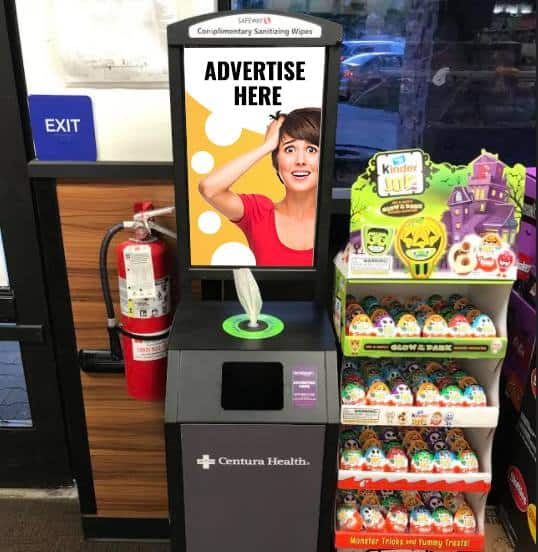📊 Why just place an ad when you can create a lasting connection? With interactive hand sanitizing stations, your brand isn’t just seen—it’s experienced. 🖱✨ Tap, play, win, and engage your customers like never before.
Hand Sanitizer Ads: As hand sanitizing stations become more advanced with digital displays, touchscreen technology, and smart analytics, advertisers’ opportunities to engage consumers in innovative ways are rapidly growing. Advertisers can create more engaging, personalized, and effective campaigns by incorporating interactive and smart technologies. Below are several tangible use cases highlight how brands can leverage these technologies in hand-sanitizing station advertising.
Interactive Surveys and Feedback Forms
Use Case: A retail brand places an interactive hand sanitizing kiosk in malls or retail stores. After using the sanitizer, customers are prompted to take a short survey on their shopping experience or product preferences. In exchange, they receive an instant discount code for their next purchase.
Why It Works:
Customer Engagement: By offering an immediate incentive, the brand encourages higher survey participation. Data Collection: The brand gathers valuable real-time feedback on customer preferences, allowing them to adjust their offerings accordingly. Increased Foot Traffic: Discount codes encourage customers to return to the store, driving more foot traffic.
Gamified Advertising Campaigns
Use Case: A fast-food chain installs interactive hand sanitizing stations in airports or transportation hubs. After sanitizing their hands, users are invited to play a quick game on the touchscreen. Winners receive a coupon or digital voucher for a free item or discounted meal.
Why It Works: Engagement: Gamification captures attention and makes the interaction fun and memorable. Brand Awareness: Consumers are more likely to remember brands that engage them in a unique way. Immediate Conversion: Coupons or digital vouchers can be redeemed in nearby restaurant locations, driving immediate sales(Adzze).
Real-Time Advertising Customization with AI
Use Case: A fitness brand uses AI-powered hand sanitizing stations in gyms. The smart kiosk detects demographic data like age and gender using facial recognition or other inputs. Based on this data, it displays tailored ads for products like protein supplements, workout gear, or recovery drinks.
Why It Works: Personalization: Tailored ads based on real-time data create a more relevant and personalized shopping experience. Data-Driven Targeting: AI helps refine the messaging to suit specific audiences, improving ad effectiveness. Higher Engagement: Personalized ads are more likely to resonate with users, driving higher engagement rates and conversions.
Health Monitoring and Data Integration for Healthcare Providers
Use Case: A healthcare provider integrates hand sanitizing stations with biometric sensors that measure basic health metrics, such as temperature or heart rate. After sanitizing, users receive their results on-screen along with health tips or relevant information on healthcare services, such as flu shot reminders or clinic appointment bookings.
Why It Works: Health-Centric Messaging: The connection between sanitizing and health monitoring strengthens the brand’s focus on wellness. Lead Generation: Healthcare providers can collect contact information for follow-up services, such as vaccine appointments. Brand Trust: Offering helpful health insights builds trust and positions the healthcare provider as a valuable resource for wellness(
Augmented Reality (AR) Integration for Product Trials
Use Case: A cosmetics company sets up hand sanitizing kiosks in high-end department stores. After using the station, users are prompted to scan a QR code that opens an AR experience on their phones, allowing them to “try on” different makeup shades virtually. Users can then proceed to the cosmetics counter to purchase the products they tried.
Why It Works: Enhanced User Experience: AR creates an interactive, immersive experience that makes product discovery fun and easy. Seamless Conversion: By integrating AR with the store’s offerings, users can move from virtual trials to real-world purchases in minutes. Brand Differentiation: The use of cutting-edge AR technology positions the brand as innovative and forward-thinking (Adzze).
Location-Based Targeting with Geofencing
Use Case: A travel agency partners with airports to place smart hand sanitizing stations near boarding gates. Using geofencing technology, the stations push location-specific travel deals to passengers’ smartphones, offering last-minute vacation packages or discounts for their next trip.
Why It Works: Contextual Relevance: Since users are already in a travel mindset, offering them personalized travel deals at the airport increases the likelihood of engagement. Mobile Integration: Geofencing connects the digital ad to the user’s mobile device, driving further engagement and immediate action. Increased Conversion: Time-sensitive offers encourage immediate decision-making, boosting conversion rates.
Conclusion
As interactive and smart technologies continue to advance, hand sanitizing stations are evolving from simple hygiene tools into powerful, data-driven marketing platforms. From gamification and AI personalization to AR integration and health monitoring, brands can use these technologies to create memorable, engaging experiences for consumers while driving both immediate and long-term conversions. By leveraging the unique setting and habitual nature of hand sanitizing, these technologies provide a perfect opportunity for brands to connect with consumers in innovative and impactful ways.
Brands that spend on promotional hand sanitizer will experience a double effect compared to spending on online digital Ads. Why? Hand sanitizer advertising.
Learn more about other creative advertising tactics in Pharmacies – watch the video below.






